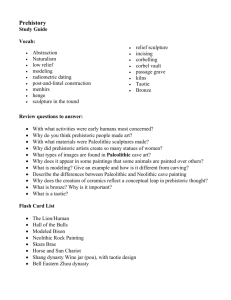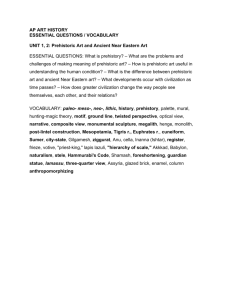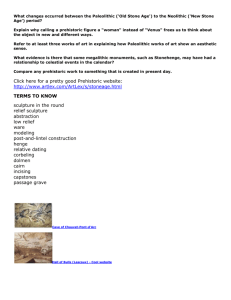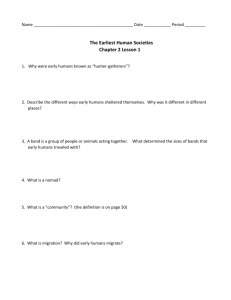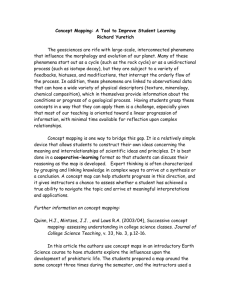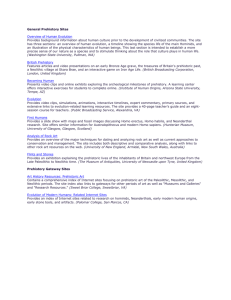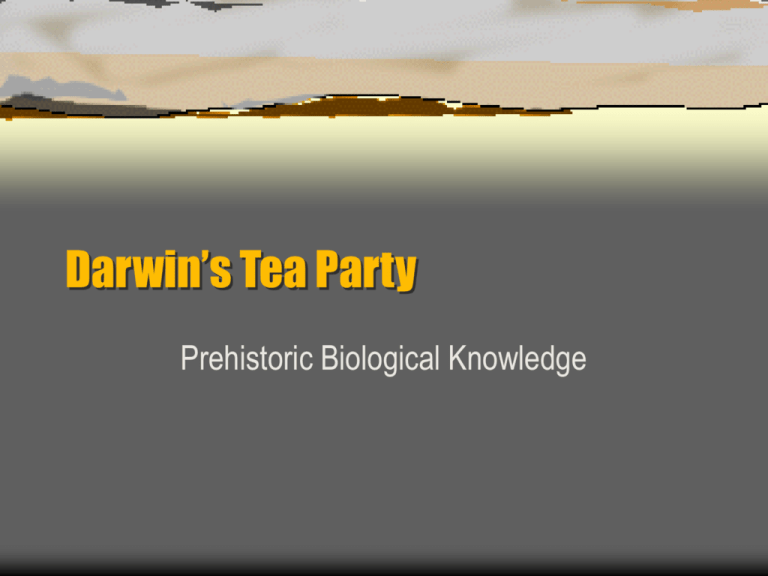
Darwin’s Tea Party
Prehistoric Biological Knowledge
Timeline: Prehistoric Era
I.
PREHISTORIC ERA (Origins to 6,000 ya)
Origins Period (15 bya to 2.5 mya)
Origins of the universe (“Big Bang”) 15 bya
Origins of the Earth (5 bya)
Origins of Life (3 bya)
Origins of Hominids (Australopithecus) hominid biological evolution 5
mya
II. Paleolithic Period (2.5 mya – 10,000 ya)
Australopithcus, Homo erectus, H. habilis, hominid biological evolution
Emergence of Homo sapiens (150,000 ya?), human cultural evolution
III. Neolithic era (10,000 – 6,000 ya)
“Invention” of agriculture and animal husbandry
Birth of civilization/history/end of prehistory 6,000 ya to now
Prehistoric Biological Knowledge
Biological knowledge is human knowledge of the
living environment.
The living environment includes animals
(including humans), plants, and micro-organisms
Biological Knowledge has been crucial to the
survival and spread of Homo sapiens (Human
beings) from the very beginning.
Prehistoric Biological Knowledge
This presentation looks at Biological Knowledge
during the prehistoric period; specifically, from
the upper (more recent) Paleolithic (100,000 ya)
era to the end of the Neolithic era (6,000 ya).
The main question it examines is:
how has biological knowledge transformed human
society?
Prehistoric Biological Knowledge
Paleolithic Era (2.5 mya to 10,000 ya)
The earliest human societies survived by hunting
and gathering of fruits and other wild vegetation.
They also scavenged from already dead
animals.
These are called hunting and gathering
societies
Prehistoric Biological Knowledge
“The Hadzabe, an indigenous nomadic hunter-gatherer
population in northern Tanzania…” Nationalgeographic.com
Photograph by Jenny Kubo
Prehistoric Biological Knowledge
Paleolithic Era (2.5 mya to 10,000 ya)
Hunter-gatherer society was relatively small (a
few hundred at the most)
Hunter-gatherer society was also relatively
egalitarian (no rich and poor)
Prehistoric Biological Knowledge
Paleolithic Era (2.5 mya to 10,000 ya)
The biological knowledge of hunting-gathering
societies included:
Knowledge of the habits, behaviour and properties
of animals in their environment.
Knowledge of the nutritional, medicinal, toxic,
hallucinogenic and other properties of plants, herbs,
roots and tubers in their environment.
Prehistoric Biological Knowledge
Paleolithic Era (2.5 mya to 10,000 ya)
Other kinds of knowledge possessed by hunting-gathering
societies is demonstrated by the stone tools and weapons
they created and later discovered by scientists.
Prehistoric Biological Knowledge
Paleolithic Era (2.5 mya to 10,000 ya)
Stone tools and weapons were crucial to the survival of humanity
As important as these were, however, they aren’t exactly
biological knowledge. These are examples of physical
knowledge
Prehistoric Biological Knowledge
Paleolithic Era (2.5 mya to 10,000 ya)
Hunter-gatherer societies lasted for over one
hundred thousand years
This is much longer than all of recorded history
Today only a few such societies remain
This map shows the gradual
disappearance of the huntinggathering way of life.
Prehistoric Biological Knowledge
Early hunter-gatherers-scavengers depended on
Knowledge of animals and plants for their
survival.
Today some of this traditional knowledge is
being sought out by modern science.
However, much of it is disappearing due to the
expansion of modern society into their natural
environment.
Early evidence of knowledge and appreciation of
animals
comes fromBiological
caves such as Knowledge
that of Lascaux,
Prehistoric
France and Altamira, Spain.
Prehistoric Biological Knowledge
Cave painting of three
aurochs (now extinct)
from Lascaux, France.
Prehistoric Biological Knowledge
Note depiction of
a bison and a
human figure
The bison seems
to have gored or
is about to gore
the human figure
Prehistoric Biological Knowledge
Today there are only a few remaining prehistoric
cultures.
These are cultures that still survive by hunting
and gathering
Some also practice small scale agriculture
Prehistoric Biological Knowledge
Such groups include the
Waorani of the Amazon rain
forest
The Waorani culture has
accumulated an impressive
body of biological knowledge
They know all of the intimate
details of the key plants and
animals in their environment
Waorani with blow gun
Zoltan Kacs http://zoltantakacs.com/zt/pw/na/index.shtml
Prehistoric Biological Knowledge
Like other hunter-gatherer cultures,
their biological knowledge focused
on recognizing:
The valuable properties of plants,
roots, herbs
Medicinal properties of the living plants
and creatures in their environment
The habits and valuable properties of
animals in their environment
See text for an example
Working with a Waorani Shaman in the Amazon
(Ecuador).
Photo by Steven R. King, 1996
Connie Veilleux and Steven R.King, Ph.D.
Linda Morganstein, editor An Introduction To Ethnobotany
http://www.accessexcellence.org/RC/Ethnobotany/pa
ge2.html
Prehistoric Biological Knowledge
Photo by Clayton Robarchek; ©all rights reserved.
“In the late afternoon, a young
Waorani mother strips fibers from
leaves for string-making. The
fibers will be boiled and dried
before being rolled into string and
then woven into nets, hammocks,
and bags”.
Clayton Robarchek and Carole Robarchek,
Waorani: The Contexts of Violence and War. Harcourt
Brace and Company 1998
http://webs.wichita.edu/anthropology/faculty/robarchek/
Prehistoric Biological Knowledge
The Souma tribe in Central Africa is another
example of a culture that has preserved valuable
biological knowledge of its environment
Bernard N’Donazi is now a doctor who was born
a member of this tribe
He remembered that after his painful initiation
ritual he was given a plant which he ingested
Prehistoric Biological Knowledge
This plant relieved his pain and caused no side
effects
It is a powerful and potentially valuable
anesthetic
As a research doctor, he is trying to find tribal
elders who will be able to recognize and find it.
Prehistoric Biological Knowledge
Unfortunately, the tribe is virtually extinct and its
elders are either dead or scattered and lost in
the growing cities of Central Africa
Civilization has displaced this tribe and with its
disappearance, we may have lost forever this
biological knowledge.
Prehistoric Biological Knowledge
The Birth of Agriculture
and
Animal Husbandry
(The Agricultural Revolution)
Prehistoric Biological Knowledge
The Agricultural Revolution
Neolithic era (10,000-6,000 ya)
About 10,000 ya large scale irrigated agriculture
began to develop in various parts of the world.
This is called the Agricultural Revolution or the
Neolithic Revolution
It radically changed both human society and
human relationship to the environment
Prehistoric Biological Knowledge
The Agricultural Revolution
(Neolithic era, 10,000-6,000 ya)
The Fertile Crescent
The ancient Near East , also called the “Fertile Crescent”. Shown here
with modern political borders. The green zone is the fertile area. This is
where large scale irrigated agriculture began about 10,000 ya.
Can you recognize any bodies of water, countries or rivers here?
Prehistoric Biological Knowledge
The Agricultural Revolution
(Neolithic era, 10,000-6,000 ya)
Agriculture led to sedentary existence and
the first permanent villages.
Prehistoric Biological Knowledge
This is an artisit's
recreation of the village
of Çatal Hüyük in what
is today Turkey. The
village had a population
of between 5,000 and
6,000 people and was
built around 6800 B.C.
Notice that the houses
are built so close
together that one had to
enter each house
through a hole in the
roof.
Çatal Hüyük (c. 6800 BC)
The Agricultural Revolution
(Neolithic era, 10,000-6,000 ya)
Prehistoric Biological Knowledge
Çatal Hüyük (c. 6800 BC)
Sedentary life, allowed
for new inventions and
tools to emerge
The Agricultural Revolution
(Neolithic era, 10,000-6,000 ya)
Prehistoric Biological Knowledge
Many of the implements
and tools shown here date
back to late Paleolithic
times. An exception is
pottery which emerges only
with the sedentary,
agricultural way of life
Prehistoric Biological Knowledge
The stone axe, hoe and
sickle were tools developed
in the early part of the
Agricultural Revolution.
Obviously, useful for an
agricultural way of life.
Prehistoric Biological Knowledge
Along with agriculture came animal husbandry,
which refers to the domestication, and rearing of
animals.
This includes all the familiar farm animals we
now know, like chickens, goats, sheep, cows,
etc…
Prehistoric Biological Knowledge
Can you guess what was probably the earliest
animal to become domesticated?
Clue: This animal was also useful to the
paleolithic hunters-gatherers.
Nearing Zero Archive List www.nearingzero.net
Prehistoric Biological Knowledge
Agriculture and animal husbandry was
eventually able to sustain more people per
square kilometer than hunting and gathering.
This map
shows how
agriculture
required far
less land to
sustain the
same
number of
people.
Prehistoric Biological Knowledge
Agriculture and animal husbandry eventually
provided food surpluses that could be stored.
Agriculture also sparked an increase in human
population
Prehistoric Biological Knowledge
www.smalltownproject.org
Prehistoric Biological Knowledge
Specialization of occupations
The food surpluses meant that not everyone
needed to work at producing food.
In the early Neolithic Villages, people began
specializing in different tasks
Prehistoric Biological Knowledge
Specialization of occupations
Many, of course, were full time farmers
Others however could exchange goods they produced
for food
Potters could produce pots and vases for storing things
Brick builders could produce bricks
Bakers could bake bread
Craftsman could make jewelry or other items, etc…
Prehistoric Biological Knowledge
In other words, society was becoming more
differentiated and more complex.
Class differences in wealth and status also
began to grow (i.e., poor and rich, rulers and
ruled).
Society was becoming more stratified or more
hierarchical
Prehistoric Biological Knowledge
By 6,000 ya (4,000 BC) some of the small
Neolithic villages had grown to be large towns
and then the world’s first cities.
These first cities, became the centers for another
kind of society called civilization.
Prehistoric Biological Knowledge
Civilization: the end of prehistory/beginning
of history
The ancient city of Babylon
Prehistoric Biological Knowledge
Civilization: the end of prehistory/beginning
of history
The modern city of New York
Prehistoric Biological Knowledge
Civilization: the end of prehistory
Civilization, in its various forms, continues to be the
dominant way of life or culture (society) in the world
today.
The Agricultural Revolution is thus crucial because it
triggered the development of the first urban civilizations.
In fact, the invention of agriculture may be the single
most important invention of the human race.
Prehistoric Biological Knowledge
Civilization: the end of prehistory
With the birth of civilization, the prehistoric ends
and the historic period (history) begins.
Prehistoric Biological Knowledge
Summary
Earliest human societies: hunter-gatherers
Existed during Paleolithic era (2.5 mya – 10,000 ya)
Hunted for animals and gathered vegetation for food
(i.e., food finders).
Small scale, relatively egalitarian societies
Key biological knowledge: knowledge of animals and
plants in their environment.
Prehistoric Biological Knowledge
Summary
Second earliest human societies: Neolithic farmers
Existed during Neolithic era (10,000 – 6,000 ya)
Agricultural (Neolithic) Revolution causes change in society
Hunters begin farming for food and raising animals (animal
husbandry) (i.e., food producers).
Larger scale, more complex and stratified societies develop
Key biological knowledge: knowledge of agriculture and
raising, breeding of animals and plants in their environment.
Prehistoric Biological Knowledge
Summary
Third earliest human societies: ancient civilization
Exists after Neolithic era to the present (6,000 ya to now)
Neolithic villages eventually grow to become first cities (birth
of civilization).
Civilization now the dominant type of society on the planet
Even larger scale, more complex and more stratified than
Neolithic
Key biological knowledge: Knowledge explodes in various
fields (see text)
Starring:
Written & directed by Gabriel Tordjman
The End


